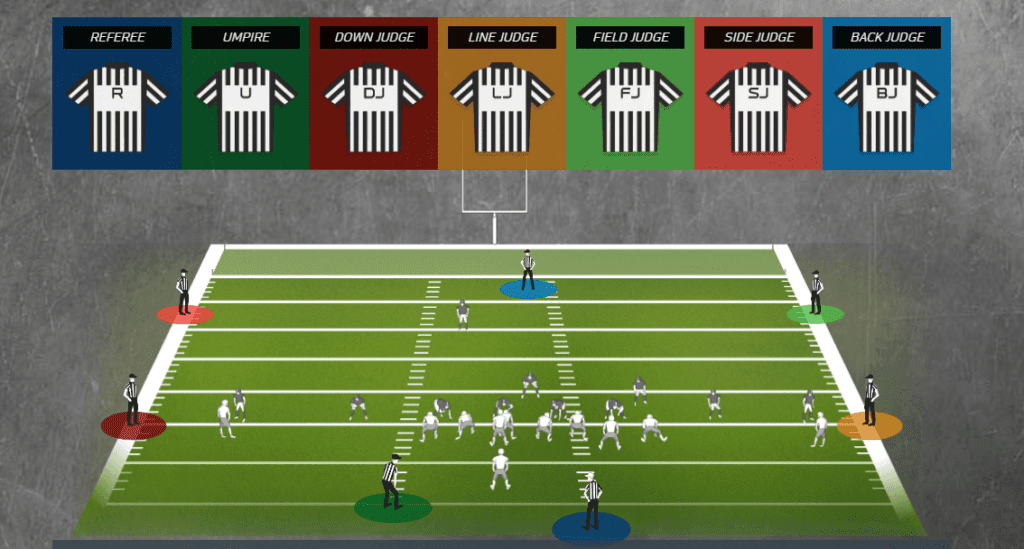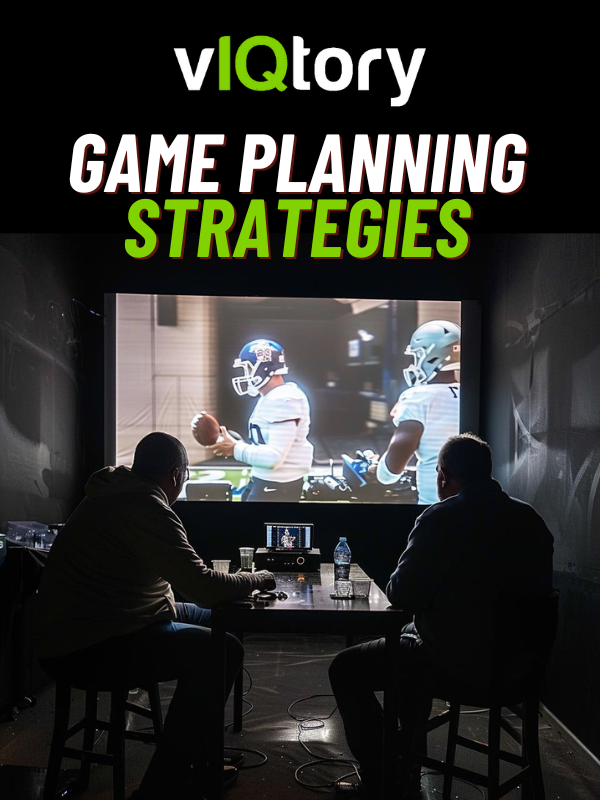All players have numbers on their jerseys for referees to differentiate who committed a foul and who is legal to catch the football. Referees, however, have numbers and letters on their uniforms for different reasons.
Football referees have letters and numbers on their uniforms to identify which position they are in. Similar to players, football referees have positions they are responsible for. The referee with the white hat is the head referee and will signal any penalties.
This article will show each of the football referee positions and what each letter/number means on the back of their uniform.
Football Referee Positions
Referees, similar to players on the field, all have positions. Each position is responsible for specific calls on the field. The goal of the football referees is to make sure the game is played as safe as possible. These seven officials will make rulings on contact plays, pre-snap plays and also scoring plays.
Defensive players and offensive players need to respect these referees because they are ultimately the final authority.
The officials wear black hats and striped shirts. One referee will wear a white hat, which we’ll cover later in the article.
High school football, college football, and the NFL may have all, or some of these referees on the field.
Below, each referee position is broken down by their letters and numbers.

Referee (R)
They are typically lined up 10-12 yards behind the line of scrimmage in the offensive backfield.
The referee is the head linesman and leader of the officiating crew who is often seen wearing a white hat.
The referee is responsible for counting offensive players and making sure there are 11 players on the field.
The referee is also accountable for roughing the passer/roughing the kicker calls.
In college football as well as the NFL, the referee is the person who makes the final decision on the play. They assess the penalties to the violating team.
The referee stands directly behind the offense. They are also responsible for kicking plays, and their primary responsibility is making sure there are no roughing the kicker penalties.
All of the referees below are responsible for making dead ball calls, which means the penalty happened after the play. The referee is also the official timekeeper during the same.
Learn How To Watch Film Properly…
Uncover your opponent’s offensive and defensive tendencies so you can easily build a game plan.
Inside You’ll Find:
- Strategies to pick apart defenses
- How to identify player weaknesses
- How to save time in your weekly breakdowns
Umpire (U)
This referee is lined up opposite of the referee, 10-12 yards behind the line of scrimmage.
In youth and high school leagues, the umpire is lined up behind the linebackers, about five to seven yards away from the line of scrimmage on defense.
The umpire is watching for holding or any lineman infractions pre-snap. The umpire is also making sure that linemen don’t go downfield on pass plays. This is often the offal that will call illegal man downfield on RPOs.
The Umpire will also be responsible for making holding, chop block, and other illegal blocking penalty calls.
Down Judge (DJ)
The down judge is the referee who is on the side of the first down makers.
He’ll direct the chain crew to move for a first down or to hold the spot.
He monitors sideline play for any out-of-bounds penalties or offsides by the defense.
The down judge will also get the spot that is to his side of the field. They are responsible for determining forward progress and eligible receivers.
Line Judge (LJ)
The Line judge is positioned on the complete opposite side of the down judge.
Similar to the down judge, the line judge is responsible for any defensive line penalties pre-snap, as well as monitoring the sideline for any late hits. This includes neutral zone infractions, offsides, and encroachment calls.
In youth and high school, these referees are also responsible for holding or pass interference penalties.
The Line Judge often works directly with the head coach of each team. If there is ever an issue, they can speak directly to the line judge who will then talk to the referee.
Often times it’s the line judge who needs to be mentally the strongest, as they will be hearing coaches, players, and fans yelling at them.
Field Judge (FJ)
The field judge stands about 20 yards behind the line of scrimmage on the defensive side of the ball.
The field judge rules for all downfield penalties, including pass interference and holding.
Another tough job for the field judge is determining if a player got both feet down on a catch (1 in high school and college).
They are also the referee that signals “touchdown” when a player crosses the goal line.
Side Judge (SJ)
The side judge is lined up in the defensive backfield roughly 20 yards from the line of scrimmage.
Like the field judge, this referee is responsible for downfield penalties, determining a catch on the sideline, and signaling a touchdown.
Back Judge (BJ)
The back judge is the deepest referee on the defensive side of the football.
This referee keeps track of the 40/25 second game clock.
The back judge can be seen holding his hand in the air when there are 10 seconds left on the play clock.
This is an essential referee to pay attention to pre-snap to avoid a delay of game penalty.
Why Do Football Referees Have Numbers?
Game officials wear numbers to differentiate themselves from other referees.
While this may not make sense at a younger level (most officials will have a letter on their back rather than a number), it’s essential at the NFL and college levels.
Just like players need to be identified on film, so do officials.
To date, there are roughly 115 officials in the NFL, so each referee will have a number.
When the league does official reviews, it’s easy to identify which referee is doing a fair or poor job.
The numbers on the referee jerseys help differentiate.
As mentioned, it’s common to see referee jerseys with just a letter on the back to determine which referee is who.
Football referees and all referees, in general, are the backbone of this sport.
They help maintain order in a physical, contact sport.
Without referees, the game would be chaos. Be sure to respect your local referees and never criticize them with insults because of a bad call.
Why Does One Referee Wear A White Hat?
The official who wears a white hat is known as the head referee.
This is the “leader” or the “captain” of the referees.
This official will talk to the coach if there’s an incident, be responsible for removing players from the game, and announce if there’s a penalty.
The referee wears a white hat to distinguish himself from the other referees.
Always look for the referee with the white hat if there’s ever an issue.
The referee with the white hat will also stop the game if necessary to address any issues.
In a hierarchical sense, the referee with a white hat can be seen as the “head coach” of referees, with each referee being the assistant.
Keep Learning
The referee positions in football are important. Every single person in the crew is responsible for shaping the game the right way.
If you liked learning about referees and the game in general, we recommend you check out our Ultimate Football Guide. Instantly grow your football IQ below.
Referees wear numbers and letters to identify themselves in a football game.
Like football players, referees have numbers and letters to let the coaches know who will make a call.
For instance, a back judge will be responsible for signaling touchdown and worry about plays that happen downfield.
Side judges are responsible for offside and any pre-snap penalties.
Every referee has a job and a duty. This is, so calls don’t go missing, and the referee isn’t trying to scan the entire play looking for a penalty.
Referees can stay hyper-focused on one part of the field and be as efficient as possible in that one area.
Referees hold all the power in any football game. They’re the reason we can play and coach football in a controlled environment. They regulate the game and ensure that everyone abides by the rules.
Although you may disagree with the referee’s calls and decisions, they’re essential to football. Without referees, there would be no way to officiate football games properly.
This is important to think about when you disagree with a call.
Let’s keep learning! Our learning center is packed with information regarding techniques, schemes, and more!
If you’re looking for more in-depth breakdowns & coaching resources, visit our coaching resource page here.









